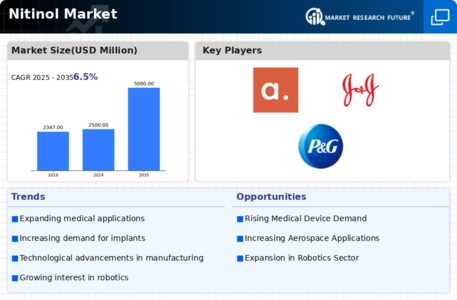Market Trends
Key Emerging Trends in the Nitinol Market
Emergence of trends and changes in Nitinol become typical features of recent years mainly because of the dynamic nature of the materials industry. The alloy nitinol, the most characteristic example of which is nitinol that is an alloy of nickel and titanium, has amazing shape-memory and superelastic properties. These properties together make it truly useful for multiple applications such as implantable medical devices, consumer electronics and many others. Among the most important market trends is the increasing domestic need of Nitinol in medical and healthcare applications. The biological compatibility combined with the nature of reacquiring the original shape after deformation make the alloy ideal for medical implants applications such as stents and guidewires. The ongoing dominance of cardiovascular disease and the quickly aging population accelerate demand for creative medical solutions. This expanding demand is propelling the Nitinol market ever onward.
Here is another significant tendency when it comes to the development of the technology, which is the rise of research and development works that discover new areas of application for Nitinol, as well as opportunities within the fields of medicine, engineering, and materials science, as well as a variety of industrial sectors. The innovative approaches discovered by engineers and researchers in different areas can use the inherent properties of the Nitinol in varied industries. Due to this, Nitinol actuators, sensors, and adaptive materials are now well-known occurrences to help with the process. Nitinol's versatility is becoming more evident as years go by, and therefore, more and more companies take more interest in working with the technology in order to be able to keep up with the various emerging technological advancements. Other than enlarging the sphere of meaningfulness towards Nitinol applications, it also nurtures innovation and provides space for collaboration across various industries.
Implementing sustainable practices in Nitinol market is considerable too. Sustainability is becoming more and more important issue and environmental concerns are not left aside. Green resources are exploited by the manufacturers to reduce Nitinol making impact on ecosystem. This consists of the deciphering of eco-minded production processes, recycling initiatives, and environment-friendly packaging. In view of the fact that sustainability has become a reason of interest for consumers and businesses, the Nitinol market is gradually assimilating to this changing paradigm, and in this regard, it forms a portion of the global movement towards environmentally responsible practices.
Globalization was one of the variables happened to be the most important in the recent trend of Nitinol products. Such fact, as the close relationships among economies and the simplification of trade across the borders, have enabled to spread and to make available these Nitinol products globally. This expansion has presented major opportunities for companies to penetrate new markets but has also led to an unprecedented level of stiff competition. Companies are challenged to find ways through which they stand out by being product innovators and giving consumers quality improvement at the lowest possible costs. This environment of competition creates a pattern for perpetual improvement leading to the evolution of the Nitinol market to greater efficiency and quality.







Leave a Comment